Maggam embroidery, an exquisite traditional craft rooted in Indian heritage, flourishes as a meticulous, intricate form of needlework.
Originating in Andhra Pradesh, Maggam embroidery, also known as Aari or Maggam work, employs a pointed needle called “maggam” to create ornate designs.
This artistry involves a delicate interplay of zari (metallic thread), sequins, beads, and silk threads, meticulously woven to embellish bridal wear, festive attire, and accessories.
Renowned for its timeless elegance, Maggam embroidery epitomizes cultural richness, adorning sarees, lehengas, blouses, and even home decor items.
This age-old craft not only preserves tradition but continues to evolve, seamlessly merging heritage with contemporary fashion trends.
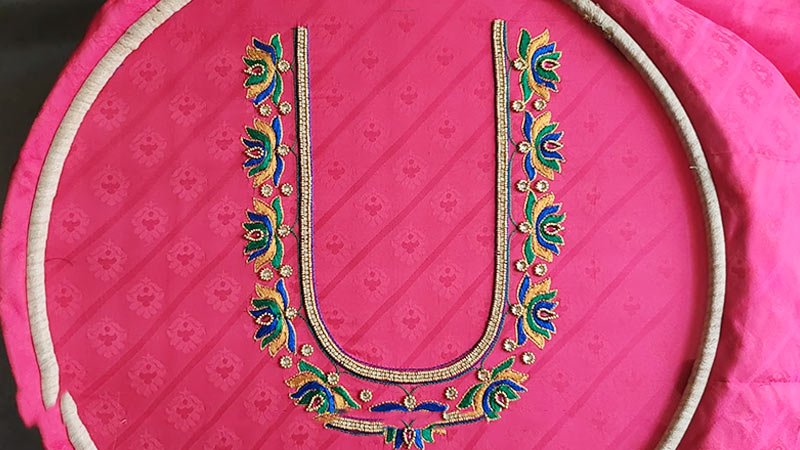
What Is Maggam Embroidery Work?
Maggam embroidery, or Aari or Maggam work, is a traditional Indian needlecraft originating in Andhra Pradesh.
This exquisite embroidery involves intricate threadwork using a special pointed needle called the “maggam.”
Its meticulous detailing and fine craftsmanship characterize the technique, making it a popular choice for embellishing bridal wear and traditional garments.
Artisans skillfully create Maggam embroidery by weaving various materials, such as zari (metallic thread), sequins, beads, and silk threads, into rich and elaborate designs.
The motifs often feature floral patterns, paisleys, and other intricate elements, showcasing the artisan’s creativity and precision.
Maggam embroidery is widely used to enhance the beauty of sarees, lehengas, blouses, and other traditional outfits, adding a touch of elegance and glamour.
This timeless craft not only preserves cultural heritage but also continues to evolve, adapting to contemporary fashion trends.
Key Uses of Maggam
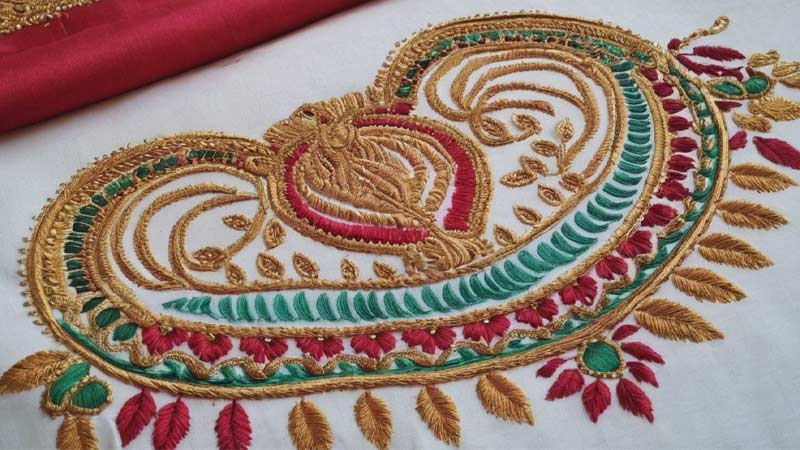
Maggam embroidery serves a multifaceted purpose, combining traditional craftsmanship with aesthetic appeal.
Primarily used as an embellishment technique, Maggam finds extensive application in Indian ethnic fashion.
Here are some critical uses of Maggam embroidery:
Bridal Attire
Maggam embroidery is pivotal in crafting bridal ensembles, transforming them into exquisite art pieces.
Bridal sarees often showcase elaborate Maggam work along borders and pallus, featuring intricate patterns like paisleys, floral motifs, and traditional bridal symbols.
Lehengas, a popular choice for modern brides, are adorned with Maggam embroidery on the blouse, skirt, and dupatta, creating a harmonious and luxurious look.
Blouses, a focal point of bridal attire, are meticulously embellished with Maggam work, adding a touch of grace and cultural significance.
The labor-intensive craftsmanship ensures that each bridal outfit becomes a unique and cherished masterpiece, symbolizing the richness of tradition on the auspicious occasion.
Festive Wear
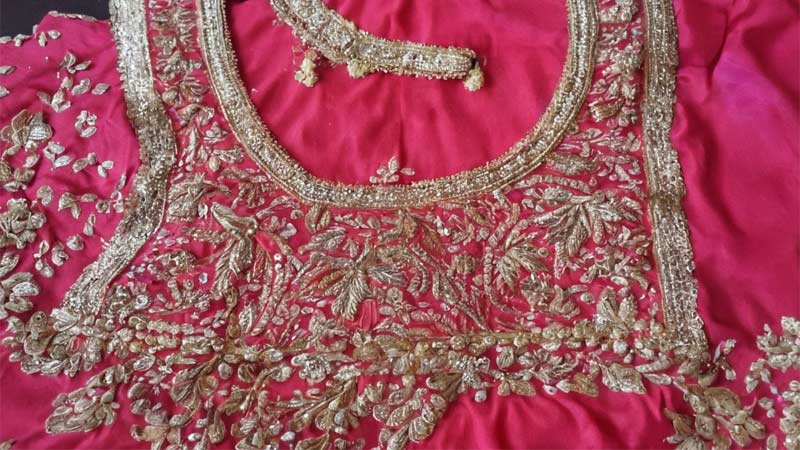
During festive seasons, Maggam embroidery transforms regular clothing into stunning expressions of cultural celebration.
Festive sarees are adorned with vibrant Maggam work, featuring bold and intricate designs that resonate with the joyous spirit of the occasion.
Lehengas and Anarkali’s festival designs showcase various colors and patterns, each telling a story of tradition and festivity.
Maggam’s work on festive wear often incorporates elements inspired by religious symbols and traditional motifs, making the garments visually represent cultural richness during special celebrations.
Special Occasions
Maggam embroidery extends its allure beyond weddings and festivals to various special occasions. Family functions, such as engagements and milestone celebrations, witness the elegance of Maggam-adorned garments.
Anarkalis, with subtle yet sophisticated Maggam detailing, become the perfect choice for religious ceremonies, offering a blend of tradition and contemporary style.
The craftsmanship inherent in Maggam embroidery ensures that attire worn on special occasions reflects a sense of luxury and exclusivity, contributing to the overall ambiance of the event.
Accessories
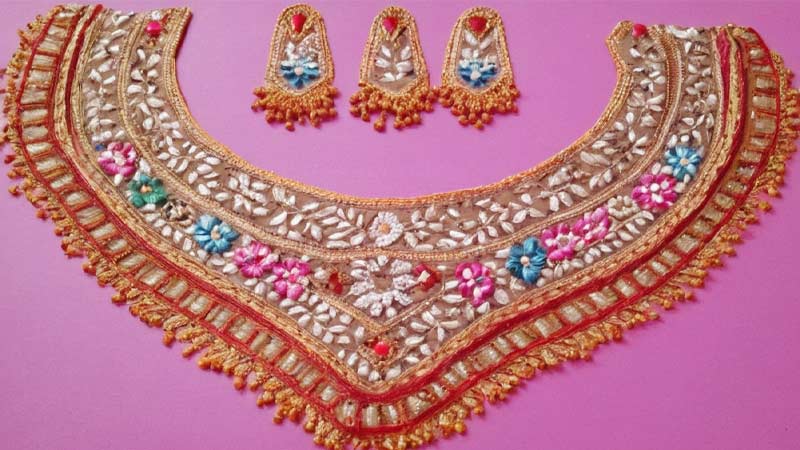
The charm of Maggam embroidery isn’t confined to clothing alone; it gracefully extends to accessories.
Handbags and clutches adorned with Maggam work become statement pieces, completing the look with coordinated elegance.
Footwear, including sandals and juttis, feature delicate Maggam embellishments, ensuring every accessory becomes a part of the cohesive ensemble.
The attention to detail in these accessories showcases the versatility of Maggam embroidery, allowing individuals to express their style through clothing and meticulously crafted accents.
Home Decor
Beyond personal attire and accessories, Maggam embroidery finds its way into home decor, bringing traditional elegance to living spaces.
Cushion covers adorned with this intricate embroidery become focal points, adding a touch of cultural richness to sofas and beds.
Wall hangings featuring Maggam’s work serve as artistic statements, blending tradition with contemporary design.
Tapestries showcase the craftsmanship on a larger scale, becoming visually stunning pieces that infuse homes with the timeless beauty of Maggam embroidery.
This extension of the art form into home decor allows individuals to create a cohesive and culturally rich ambiance within their living spaces.
Maggam Work Designs Latest
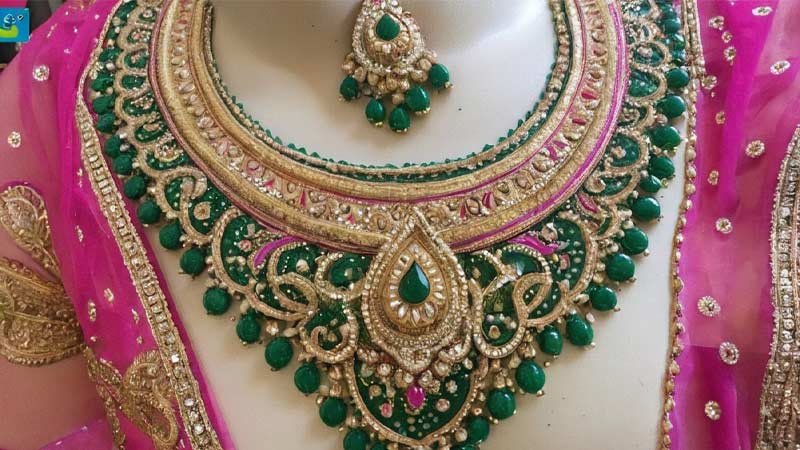
Maggam’s work designs are a testament to the intricate craftsmanship and artistic flair inherent in this traditional Indian embroidery.
These designs, characterized by their meticulous detailing and exquisite patterns, enhance the beauty of various garments and accessories.
Here are the latest popular Maggam work designs:
Floral Motifs
Floral motifs in Maggam embroidery showcase a remarkable array of natural beauty. Artisans meticulously craft elaborate roses, lotuses, and various blossoms, creating a garden of intricate charm on garments.
The delicacy and versatility of floral patterns allow them to transition between traditional and contemporary looks seamlessly.
The choice of flowers often holds cultural significance, with each petal and leaf carefully embroidered to create a tapestry of timeless elegance.
Whether adorning a saree’s pallu or enhancing the blouse’s neckline, floral motifs remain a perennial favorite, capturing the essence of nature’s beauty in every stitch.
Paisley Designs
Paisley designs, often called “mango” motifs, are a hallmark of Maggam embroidery. These teardrop-shaped patterns are intricately embroidered, forming borders or central elements on garments.
The graceful curves and flowing lines of paisley add elegance and sophistication to bridal wear and festive ensembles.
The versatility of paisley allows it to be adapted to various garment styles, ensuring a seamless integration of this timeless motif into the overall design, creating an enduring visual appeal.
Peacock Motifs
The peacock, symbolizing beauty and grace in Indian culture, takes center stage in Maggam embroidery. Elaborate feathers, vibrant colors, and intricate detailing characterize peacock motifs.
These regal designs are famous for bridal outfits, infusing a sense of grandeur and majesty.
Peacock motifs are also favored for special occasions, capturing the spirit of celebration with their wealthy and captivating presence.
The symbolism associated with the peacock adds a layer of cultural richness to the garments, making them a cherished representation of Indian heritage.
Temple Designs
Drawing inspiration from traditional temple architecture, Maggam’s work designs often feature geometric patterns and motifs reminiscent of intricate carvings.
These temple-inspired designs bring a touch of divine elegance to sarees and lehengas, making them particularly suitable for religious ceremonies and auspicious occasions.
The symmetrical and structured elements in temple designs showcase the artisan’s skill in translating architectural beauty into textile art, creating garments that resonate with cultural and aesthetic significance.
Bridal Symbols
Maggam’s work for bridal attire goes beyond mere embellishment, incorporating specific symbols and motifs with deep cultural and spiritual significance.
Elements like the mangal sutra, traditional bridal jewelry, and ceremonial symbols are intricately woven into the fabric. Each stitch symbolizes aesthetic beauty, marital bliss, and cultural identity.
These designs create a personalized narrative, allowing brides to carry forward cherished traditions and symbols as they embark on their new journey.
Buttas and Jaals
Maggam’s work frequently employs small, scattered motifs called “buttons” and interconnected patterns called “jails.”
These elements cover the fabric in a harmonious and visually appealing manner, creating a sense of continuity and unity in the overall look of the attire.
Buttas, often resembling miniature floral or paisley motifs, add a subtle yet impactful touch to the fabric.
On the other hand, jails create a captivating network of interconnected designs, showcasing the artisan’s ability to weave complexity into simplicity, resulting in a visually stunning and culturally rich garment.
Zardozi Embellishments
Zardozi, a form of metal embroidery using gold or silver threads, adds a touch of luxury and grandeur to Maggam’s work designs.
Intricate patterns and motifs are meticulously embellished with metallic threads, creating a dazzling effect on bridal wear and celebratory ensembles.
Zardozi embellishments often highlight the garment’s borders, neckline, and central elements, elevating its overall aesthetic.
The shimmering metallic threads catch the light, adding a luxurious dimension to the attire and making it a fitting choice for weddings and other special occasions.
Contemporary Fusion
Maggam’s work has embraced contemporary elements in response to evolving fashion trends, seamlessly blending traditional techniques with modern aesthetics.
Geometric shapes, abstract patterns, and unconventional color combinations are integrated into the designs, offering a fresh and dynamic interpretation of this age-old embroidery.
The fusion of traditional and contemporary elements caters to a diverse range of fashion preferences, allowing Maggam’s work to remain relevant and captivating in the ever-changing landscape of style.
This innovative approach ensures that Maggam embroidery continues captivating new generations while honoring its rich cultural heritage.
Difference Between Maggam Work and Embroidery
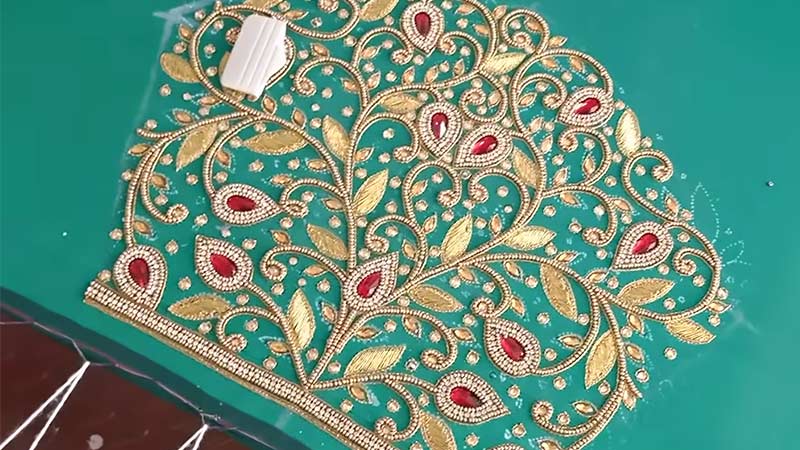
Maggam work and traditional embroidery are both intricate forms of textile embellishment, each rooted in rich cultural traditions.
While the terms are sometimes used interchangeably, it’s essential to understand the nuances that distinguish Maggam’s work from general embroidery techniques.
This distinction lies in these crafts’ specific tools, methods, and regional variations.
Let’s explore the key differences between Maggam work and embroidery in a comparative table:
| Aspect | Maggam Work | Embroidery |
| Origin | Originated in Andhra Pradesh, India. | Widespread and diverse, with roots in cultures worldwide. |
| Needle Used | Threadwork varies, encompassing various stitches like satin, chain, and cross-stitch. | Various types of needles, including crewel, tapestry, and embroidery needles. |
| Threadwork | Known for meticulous threadwork, often involving zari, beads, and sequins. | It is commonly used in embellishing bridal wear, sarees, and traditional garments. |
| Regional Variations | Prevalent in South Indian bridal attire and accessories. | Exhibits diverse styles and techniques influenced by cultural and geographical factors. |
| Application | Characterized by highly intricate and detailed designs, often focusing on surface embellishments. | It commonly involves using metallic threads like zari, enhancing the opulence of the designs. |
| Complexity | It commonly involves using metallic threads like zari, enhancing the opulence of the designs. | Offers a range of complexity, accommodating both simple and highly detailed patterns. |
| Terminology Variations | Also referred to as Aari or Maggam embroidery, showcasing regional naming conventions. | Encompasses various forms like crewel, cross-stitch, and needlepoint, reflecting global terminology distinctions. |
| Artistic Elements | Emphasizes ornate motifs such as floral patterns, paisleys, and bridal symbols, contributing to a traditional aesthetic. | Allows for artistic diversity, accommodating a multitude of motifs, themes, and styles to suit cultural and individual preferences. |
| Usage of Metallic Threads | It commonly involves using metallic threads like zari, enhancing the luxury of the designs. | While metallic threads are used in certain styles, embroidery encompasses a broader range of thread materials, including cotton, silk, and wool. |
FAQs
What is Maggam’s Work?
Maggam work, also known as Aari or Maggam embroidery, is a traditional Indian needlecraft originating from Andhra Pradesh.
Is there any difference between Maggam Work and Aari Work?
No, Maggam and Aari work are terms often used interchangeably to refer to the same traditional embroidery technique.
Wrap Up
Maggam embroidery is a testament to the rich tapestry of Indian craftsmanship, weaving together tradition and artistry.
Originating from the intricate landscapes of Andhra Pradesh, this age-old technique, executed with precision using the magnum needle, elevates garments and accessories to the realm of timeless elegance.
Whether adorning bridal attire, festive wear, or even home decor, Maggam embroidery becomes a visual symphony of cultural richness.
Its adaptability, from classic floral motifs to contemporary fusions, ensures its relevance across generations.
Maggam embroidery embellishes fabrics and threads the narrative of India’s vibrant heritage, showcasing the enduring allure of a craft that transcends time and trends.
Leave a Reply